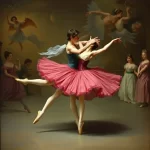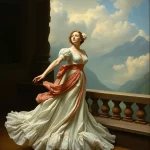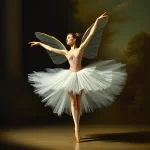Ballet: Le Diable amoureux (Napoléon Henri Reber and François Benoist, 1840)

Introduction
Ballet, an art form that combines dance, music, and storytelling, has a rich history filled with iconic works. One such work is “Le Diable amoureux,” a ballet composed by Napoléon Henri Reber and François Benoist, which premiered in 1840. Choreographed by Joseph Mazilier, this ballet is a fascinating blend of supernatural elements and romantic intrigue. The story revolves around a young man who inadvertently summons a demon, leading to a series of enchanting and perilous events.
Historical Background
Creation and Development
“Le Diable amoureux” was created during a period of significant artistic and social change in Europe. The early 19th century was marked by the Romantic movement, which emphasized emotion, nature, and the supernatural. This cultural backdrop influenced the creation of the ballet, which drew inspiration from Jacques Cazotte’s 1772 novel of the same name. The novel, a blend of romance and the supernatural, provided a rich narrative foundation for the ballet.
The collaboration between choreographer Joseph Mazilier and composers Napoléon Henri Reber and François Benoist was crucial in bringing this ballet to life. Mazilier, known for his innovative choreography, worked closely with Reber and Benoist to ensure that the music and dance seamlessly complemented each other. Their combined efforts resulted in a ballet that was both visually and musically captivating.
Premiere and Reception
“Le Diable amoureux” premiered on September 23, 1840, at the Paris Opera. The initial reception was mixed, with some critics praising the innovative choreography and music, while others were less enthusiastic about the supernatural elements of the story. Despite this, the ballet quickly gained popularity and was performed numerous times in the following years. Notable early performances included revivals in major European cities, which helped to solidify its place in the ballet repertoire.
Synopsis of the Ballet
Act I Summary
The ballet opens with the young protagonist, Alvaro, who is studying ancient texts in his quest for knowledge. Inadvertently, he summons a demon named Biondetta, who appears in the form of a beautiful woman. Alvaro is initially frightened but soon becomes enchanted by Biondetta’s beauty and charm. The act ends with Alvaro agreeing to take Biondetta with him on his travels, unaware of the dangers that lie ahead.
Act II Summary
In the second act, Alvaro and Biondetta arrive at a grand palace, where they are welcomed by the court. Biondetta’s supernatural abilities become apparent as she dazzles the court with her magical powers. However, Alvaro begins to suspect that something is amiss. His suspicions are confirmed when he discovers Biondetta’s true identity as a demon. The act ends with Alvaro in a state of turmoil, torn between his love for Biondetta and his fear of her demonic nature.
Act III Summary
The final act sees Alvaro confronting Biondetta, demanding that she reveal her true intentions. Biondetta, moved by Alvaro’s bravery and love, decides to renounce her demonic nature. However, the forces of darkness are not so easily thwarted. A climactic battle ensues, with Alvaro ultimately emerging victorious. The ballet concludes with Biondetta transformed into a mortal woman, and she and Alvaro are united in love.
Finale
The conclusion of “Le Diable amoureux” is both dramatic and poignant. The transformation of Biondetta from demon to mortal symbolizes the triumph of love and humanity over supernatural forces. This resolution underscores the Romantic themes of the ballet, emphasizing the power of emotion and the human spirit.
Musical Composition
Composer’s Role
Napoléon Henri Reber and François Benoist played pivotal roles in the creation of “Le Diable amoureux.” Reber, a prominent composer of the time, was known for his ability to blend traditional and innovative musical elements. Benoist, an accomplished organist and composer, brought his expertise in orchestration to the project. Together, they crafted a score that was both evocative and dynamic, enhancing the narrative and emotional depth of the ballet.
Musical Themes and Motifs
The music of “Le Diable amoureux” is characterized by recurring themes and motifs that reflect the story’s supernatural and romantic elements. One notable motif is the “demon theme,” a haunting melody that accompanies Biondetta’s appearances. In contrast, the “love theme” is a lyrical and tender melody that underscores the developing relationship between Alvaro and Biondetta. These musical themes help to convey the emotional nuances of the story, drawing the audience deeper into the narrative.
Famous Recordings and Performances
Over the years, there have been several notable recordings and performances of the music from “Le Diable amoureux.” One iconic recording is the 1960 performance by the Paris Opera Orchestra, conducted by Jean-Baptiste Mari. This recording is celebrated for its fidelity to the original score and its expressive interpretation. More recent performances, such as those by the Royal Ballet and the Bolshoi Ballet, have also received acclaim for their musical and choreographic excellence.
Choreography and Dance
Choreographer’s Vision
Joseph Mazilier’s vision for “Le Diable amoureux” was to create a ballet that was both visually stunning and emotionally resonant. His choreography was innovative for its time, incorporating elements of mime and dramatic expression to enhance the storytelling. Mazilier’s interpretation emphasized the contrast between the human and supernatural worlds, using movement to convey the characters’ inner conflicts and emotions.
Signature Dance Numbers
One of the standout dance numbers in “Le Diable amoureux” is the Pas de Deux between Alvaro and Biondetta in Act II. This dance is a delicate and intricate duet that captures the romantic tension between the characters. Another notable scene is the “Demon’s Dance,” a solo performance by Biondetta that showcases her supernatural powers through dynamic and expressive movements. These key dances are integral to the narrative, reflecting the characters’ relationships and the story’s dramatic arc.
Notable Interpretations
Over the years, different productions of “Le Diable amoureux” have brought unique interpretations to the choreography. Some have emphasized the ballet’s Romantic elements, focusing on the emotional and lyrical aspects of the dance. Others have highlighted the supernatural and dramatic components, using bold and theatrical movements to convey the story’s darker themes. These varied interpretations demonstrate the ballet’s versatility and enduring appeal.
Characters and Roles
Main Characters
- Alvaro: The young protagonist who inadvertently summons the demon Biondetta. Alvaro is characterized by his curiosity, bravery, and ultimately, his capacity for love.
- Biondetta: A demon who appears in the form of a beautiful woman. Biondetta is both enchanting and dangerous, embodying the ballet’s themes of love and the supernatural.
Supporting Characters
- The Court: A group of nobles who welcome Alvaro and Biondetta to the palace. They serve as a backdrop to the main action, highlighting the contrast between the human and supernatural worlds.
- Forces of Darkness: Supernatural entities that oppose Alvaro and Biondetta’s union. They add tension and drama to the story, culminating in the climactic battle in Act III.
Famous Dancers
Several renowned dancers have portrayed the roles of Alvaro and Biondetta over the years. Notable performers include Lucien Petipa, who originated the role of Alvaro, and Carlotta Grisi, who was celebrated for her portrayal of Biondetta. More recent interpretations by dancers such as Rudolf Nureyev and Natalia Makarova have also received critical acclaim.
Cultural and Artistic Impact
Influence on Ballet and Dance
“Le Diable amoureux” has had a lasting impact on the world of ballet and dance. Its innovative choreography and integration of supernatural themes influenced subsequent works and choreographers. The ballet’s emphasis on dramatic expression and storytelling helped to pave the way for more narrative-driven ballets in the Romantic era and beyond.
Cultural Significance
The ballet’s themes of love, transformation, and the supernatural have resonated with audiences and artists alike. “Le Diable amoureux” has inspired adaptations in various forms of media, including literature, theater, and film. Its influence can be seen in works that explore similar themes of romance and the supernatural.
Legacy and Revivals
“Le Diable amoureux” continues to be performed and celebrated today. Major revivals by companies such as the Paris Opera Ballet and the Bolshoi Ballet have brought the ballet to new generations of audiences. Modern adaptations often incorporate contemporary elements while staying true to the original’s spirit, demonstrating the ballet’s enduring relevance and appeal.
Iconic Productions
Historic Productions
One of the most famous historical productions of “Le Diable amoureux” was the 1840 premiere at the Paris Opera. This production featured Lucien Petipa and Carlotta Grisi in the lead roles, with set designs by Pierre-Luc-Charles Ciceri. Another notable production was the 1866 revival at the Bolshoi Theatre, which introduced new choreography by Marius Petipa.
Contemporary Productions
Recent productions of “Le Diable amoureux” have brought fresh interpretations to the ballet. The Royal Ballet’s 2015 production, for example, incorporated modern set and costume designs while maintaining the original choreography. This blend of old and new elements has helped to keep the ballet relevant and engaging for contemporary audiences.
Production Design
The set, costume, and lighting design in various productions of “Le Diable amoureux” have played a crucial role in bringing the story to life. Historic productions often featured elaborate sets and costumes that emphasized the contrast between the human and supernatural worlds. Contemporary productions have experimented with minimalist designs and innovative lighting techniques to create a more immersive and dynamic experience.
Critical Reception and Reviews
Initial Critical Response
The initial critical response to “Le Diable amoureux” was mixed. Some critics praised the ballet’s innovative choreography and music, while others were less enthusiastic about its supernatural themes. Despite this, the ballet quickly gained popularity with audiences, who were captivated by its dramatic and romantic elements.
Modern Reviews
Contemporary critics and audiences continue to appreciate “Le Diable amoureux” for its emotional depth and artistic innovation. Modern reviews often highlight the ballet’s timeless themes and its influence on subsequent works. The ballet’s ability to resonate with audiences across different eras is a testament to its enduring appeal.
Fun Facts and Trivia
Behind-the-Scenes Stories
One interesting behind-the-scenes story involves the original production’s set design. Pierre-Luc-Charles Ciceri, the set designer, created an elaborate palace set that included hidden trapdoors and mechanical effects to enhance the supernatural elements of the story. These innovative designs added to the ballet’s visual spectacle and helped to create a more immersive experience for the audience.
Notable Performers
Several famous dancers have been associated with “Le Diable amoureux” over the years. Lucien Petipa, who originated the role of Alvaro, was known for his technical skill and dramatic expression. Carlotta Grisi, celebrated for her portrayal of Biondetta, brought a captivating blend of grace and intensity to the role. More recent performers, such as Rudolf Nureyev and Natalia Makarova, have also left their mark on the ballet.
Trivia
- The novel “Le Diable amoureux” by Jacques Cazotte, which inspired the ballet, is considered one of the earliest examples of fantasy literature.
- Joseph Mazilier, the choreographer, was known for his ability to blend classical ballet techniques with dramatic storytelling.
- The ballet’s music features a unique combination of orchestral and choral elements, adding to its rich and dynamic sound.
Conclusion
Summary of the Ballet’s Importance
“Le Diable amoureux” is a significant work in the world of ballet for its innovative choreography, evocative music, and compelling narrative. The ballet’s blend of romance and the supernatural, along with its emphasis on dramatic expression, has influenced subsequent works and helped to shape the development of ballet as an art form.
Final Thoughts
“Le Diable amoureux” remains a captivating and relevant work, demonstrating the enduring power of love and the human spirit. Its rich history, artistic innovation, and emotional depth continue to resonate with audiences today. Whether you are a seasoned ballet enthusiast or a newcomer to the art form, “Le Diable amoureux” offers a timeless and enchanting experience.
FAQ
What is the central theme of this ballet?
The central theme of “Le Diable amoureux” is the transformative power of love, set against a backdrop of supernatural intrigue.
Who are the main characters in this ballet?
The main characters are Alvaro, a young man who summons a demon, and Biondetta, the demon who appears in the form of a beautiful woman.
What is the most famous dance number in this ballet?
One of the most famous dance numbers is the Pas de Deux between Alvaro and Biondetta in Act II, which captures the romantic tension between the characters.
How long does a typical performance of this ballet last?
A typical performance of “Le Diable amoureux” lasts approximately two hours, including intermissions.
Are there any modern adaptations of this ballet?
Yes, there have been several modern adaptations of “Le Diable amoureux,” including recent productions by the Royal Ballet and the Bolshoi Ballet that incorporate contemporary elements while staying true to the original’s spirit.
Why is this ballet considered important in the history of dance?
“Le Diable amoureux” is considered important for its innovative choreography, evocative music, and compelling narrative. It has influenced subsequent works and helped to shape the development of ballet as an art form.





